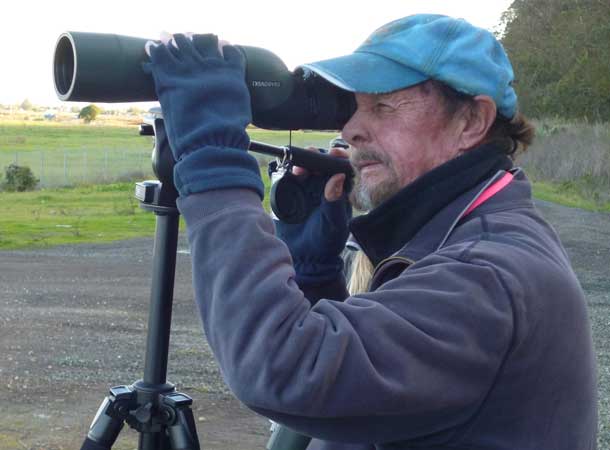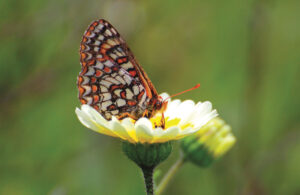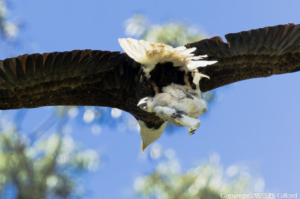‘Tis the season for counting birds.
This year’s Christmas Bird Count, or CBC, kicked off on December 15 with “Cheep Thrills,” a count based in northeast Marin County. I was lucky enough to tag along with PRBO Conservation ornithologist Rich Stallcup and partner Heather Cameron for the afternoon. The two are veterans of hundreds of CBCs–Rich once did 12 counts in a single year.
If the Christmas Bird Count elicits visions of blue-haired biddies strolling through the woods pointing at songbirds, think again. A CBC is an intense, all-day birding marathon. Rich’s day began as he stood in the pre-dawn rain playing tapes of owl calls.
Each count takes place in a specific 15-mile diameter circle, divided into sections with teams assigned to each one. (Check out our earlier CBC overview story.) The Cheep Thrills circle includes parts of San Rafael, all of Novato, and a chunk of West Marin. Rich and Heather’s section included some of the Novato Sanitary District’s wastewater treatment ponds.
Here are some moments in the life of a couple of lifelong birders on the biggest birding day of the year.
***
-
Like many wastewater ponds, the Novato Sanitation District ponds are a surprisingly good birding destination. Photo by Juliet Grable.
The first pond was dotted with ducks. Rich counted, Heather kept notes and pointed out things Rich might not be seeing through his spotting scope.
“One eared grebe.”
“Three hundred shovelers.”
“Five more turkey vultures.”
“What about ruddies; anyone count ruddy ducks yet?”

-
Eared grebe, Creative Commons photo by Yathin.
Birds were everywhere: ducks, coots and grebes in the ponds, blackbirds in the tule, sparrows flushing from the coyote-bush alongside the dirt roads, ruby-crowned kinglets flitting in the eucalyptus, raptors perched on distant wires, skeins of geese threading through the air.
“Say’s phoebe!” Rich announced. He turned to me. “Do you know that bird? Gray chest, rusty tummy…”
“One more red-tailed, in the oak,” Heather said.
Rich confirmed. “One 2011 model red-tailed hawk.”
*
I was still staring after the four ring-necked ducks that were paddling away from the shore when Rich stopped the car abruptly.
“What is it?” Heather asked.
“Swallows. This is big. Let’s get out.”
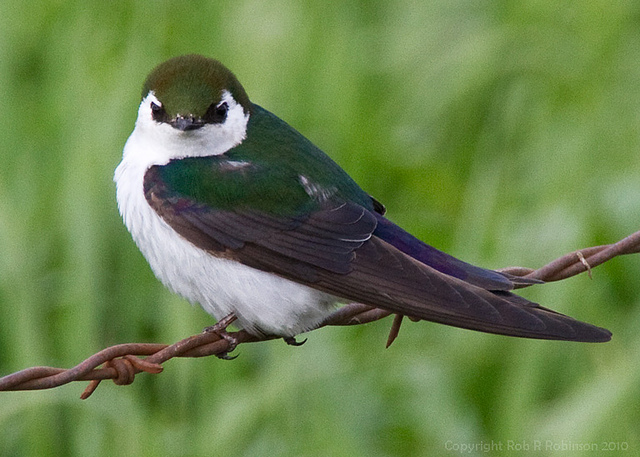
-
Violet green swallow. Creative Commons photo by Rob Robinson.
The three of us spilled out of the car and scanned just over the horizon with our binoculars.
“Violet-green and tree swallows,” Rich said. “See their white ‘saddlebags’?” The swallows swooped and turned, crossing paths, appearing and disappearing. I had trouble following single birds, much less estimating their numbers.
“How in the world do you count them?”
“Practice,” Rich replied, then told a story about honing his counting skills with friends. One would turn over a jar full of beans on the floor, then cover them up a few seconds later. Each person would have to make a guess.
“We were strange youth.”
*
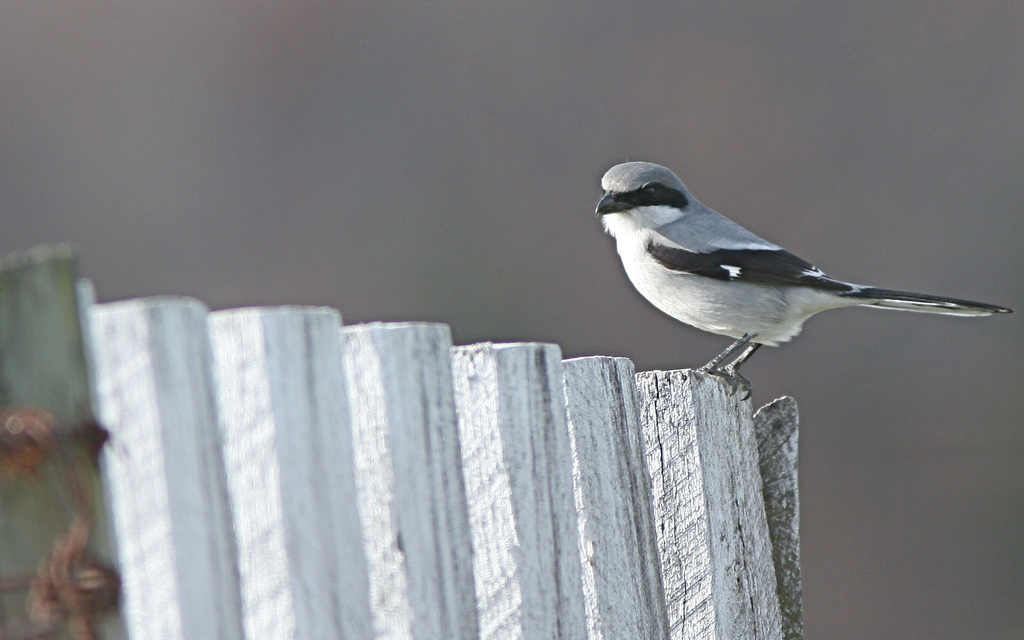
-
A loggerhead shrike on a fence. Creative commons photo by Henry T. McLin.
Rich had turned his attention away from the swallows and was scanning a field in the distance beyond one of the ponds. He tapped my arm in excitement.
“Look, look; just in front of the green sign on Highway 37, on the fence just in front.”
“In front of the green sign…”
“Oh, beautiful!” Heather exclaimed. I finally found the bird; it was a loggerhead shrike.
The shrike is a striking bird, gray with a black mask and black-and-white wings, but the sighting was beautiful for another reason: Over the years the CBC has revealed a steep decline in this species, which likes to perch strategically on fenceposts. It preys on insects, which it skewers on thorns or barbed wire.
Despite the decline in shrikes, many trends revealed by the CBCs are positive, Rich says. Marin Audubon has been actively buying land and restoring marshes, including Bahia Wetlands in northeast Novato. The abundance and variety of birds suggests this strategy is paying off.
*
At another pond Rich took on the task of counting Canada geese clustered on the far shore while Heather hunted for kinglets in the windbreak. Rich called Heather over to the scope.

-
Ross’s geese in flight over the Sacramento River Wildlife Refuge. Public domain image, USFWS.
“Oooh…”
“I thought you’d say that.”
“Ross’s geese?”
“Three of them are, but look at the one; it’s a little darker, with a thicker neck.”
“Oh, it’s a snow goose!”
The four smaller white geese stood out among the dark, heavy bodies of the Canada geese. Then Rich spotted a white-fronted goose camouflaged among them. This bird is dark like a Canada goose but much smaller, with no cheek patch. I was still looking for it when, for reasons known only to the geese themselves, dozens of them flushed, flew to the east, circled, then returned, splash-landing back in the pond, honking all the while.
“This should be a needle in a haystack,” Rich said. There were over 600 Canada geese in the pond. The three of us scanned the pond, looking for a single white-fronted goose.
“I see it!”
“It’s near the white geese.”
“Four Canadas over from the white ones.”
A needle with feathers.
*
“Nobody pretends that we count every bird,” Rich had told me earlier. “But when the Count is done year after year in the same place with the same level of expertise, over time we start getting a reliable database.”
Late in the afternoon we crept along the levee, a full pond full of geese on our right, a drained pond on our left. As we drove, a small flock of American pipits flushed. The pipit looks kind of like a sparrow, kind of like a sandpiper, and a lot like the ground it blends into. Its most distinguishing features are a necklace of buffy streaks and white-edged tail.
“How many did you say?” Heather asked.
“Twenty-two. That probably means there’s forty-two.” The car continued creeping along the levee. Another small flock of pipits flushed. Then another.
“How about fifty, exactly.”
“Not one more,” I joked. As soon as I said it, a single straggler took to the air.
“Make that fifty-one.”
*
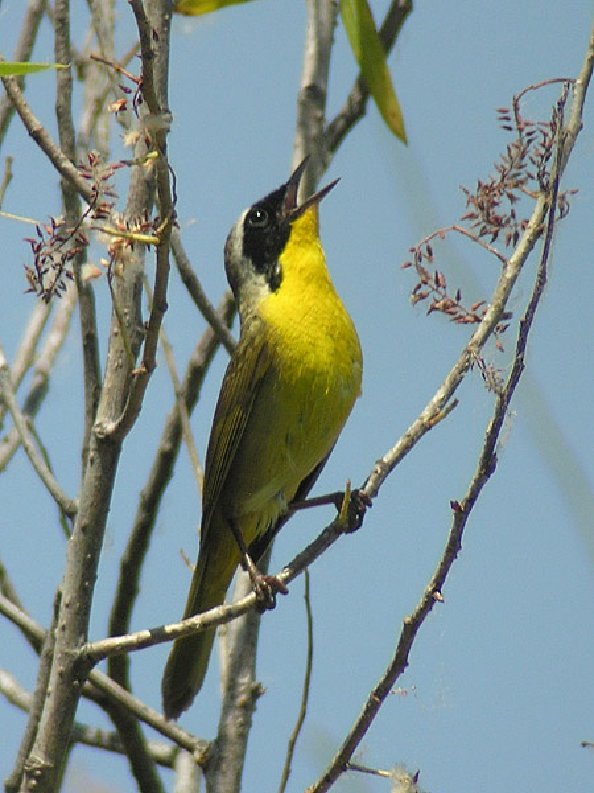
-
Common yellowthroat. Creative commons photo by Len Blumin.
Birding is a paradoxical activity. You must be extremely focused, yet at the same time highly distractible. After flushing the pipits we stopped on the east side of the pond to see if we could find anything else hiding among the Canada geese. Something caught my eye: half a dozen fluttering white forms against the blue of sky.
“Peeps!” I said, happy to be pointing something out myself. Rich swung around.
“Six or seven least sandpipers,” he called out. I kept tracking them, but Rich had moved on.
“Merlin! Merlin!” he cried, excited. I tore myself away from the sandpipers just long enough to see the falcon swoop out of view. The brief presence of the raptor set the geese off; the honking sounded like an agitated traffic jam in a crowded parking lot. I was still looking for the merlin when Rich called out again.
“Common yellowthroat! On the fence, hurry; it won’t be there long.”
*
Some species were impressive for their sheer numbers, like the hundreds of northern shovelers and Canada geese in the ponds, and the dozens of red-winged blackbirds jammed wing-to-wing along a barbed wire fence. It seemed like there was a black phoebe on every fence section, chirping and swooping, and almost any time I scanned the sky, at least one turkey vulture soared overhead, wings see-sawing on the currents.
Other species impressed us with their rarity or uncommon beauty, such as the shrike and the pair of cinnamon teal we saw next to the tule in one of the smaller ponds. Still others were memorable for a particular combination of grace and humor, like the pair of great egrets fighting over a piece of prime real estate next to one of the ponds. They took to the air, the one in front nearly grazing the water with its regal white wings, the one on its heels croaking audibly.
“It’s a personal space issue,” Rich explained. “One landed on the wrong levee; now it must be chased for half a mile.”
This year’s Cheep Thrills circle yielded 161 species. Rich and Heather documented 104 in their section.
Learn more about the Christmas Bird Count.

.jpg)

